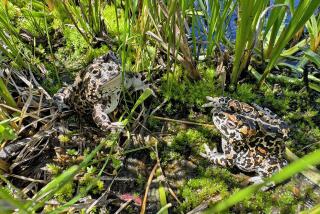Western spadefoot toad a factor in business park project
- Share via
The future of a proposed multiuse development in the Santa Clarita Valley could rest partly on its relationship with some short-legged, bug-eyed amphibians. Toads, to be precise.
Construction of Sterling Gateway, a 75-acre business park, won’t be able to get underway until the developers fulfill at least one environmental requirement: Dedicate land where Western spadefoot toads can breed.
Sterling’s proposed business park in Valencia’s Hasley Canyon just north of California 126 will complement the nearby construction of some 250 single-family homes the company also is planning.
But the California Department of Fish and Game recommended mitigation measures during the project’s initial environmental review in a move to protect the toads, which are classified by the agency as a “California species of special concern.”
So Sterling has offered to buy a 9,000-square-foot chunk of county-owned land to create a pond where the creatures can procreate.
The land’s topography and drainage could provide a suitable “seasonal pool habitat” for the toads, according to a report to the Los Angeles County Board of Supervisors by William T Fujioka, the county’s chief executive officer.
On Tuesday, the supervisors are expected to consider whether to sell the land, valued at around $4,000. In order to sell, the county must declare that it no longer needs the land as a park.
Representatives of Sterling Gateway did not respond to requests for comment.
The sale of land, the equivalent to around 0.2 of an acre, was not expected to negatively affect the 67-acre Equestrian Center, a popular spot for horseback riders, county officials said.
According to Fujioka’s report, construction of the toad pond would allow the species to breed for four years, “after which the area will be used for park purposes in perpetuity.” If the developers fail to use the land for the stated purpose, it would return to the county, Fujioka said.
Information published by Biology Compliance Inc., which analyzes rare species and plants, describes the toads as remaining “dormant or semi-dormant” in small burrows near seasonal rain-pools for most of the year and entering aquatic habitats only for breeding.
Although being designated a species of special concern doesn’t protect the Western spadefoot toad as “endangered,” it ensures that any potential impact to the species is considered when a project is undergoing a environmental review, according to the Department of Fish and Game.
In 2004, for example, local developer Newhall Land faced temporary setbacks at two of its projects after toads were discovered and the company was required to construct a couple of ponds for the creatures.
More to Read
Sign up for Essential California
The most important California stories and recommendations in your inbox every morning.
You may occasionally receive promotional content from the Los Angeles Times.














